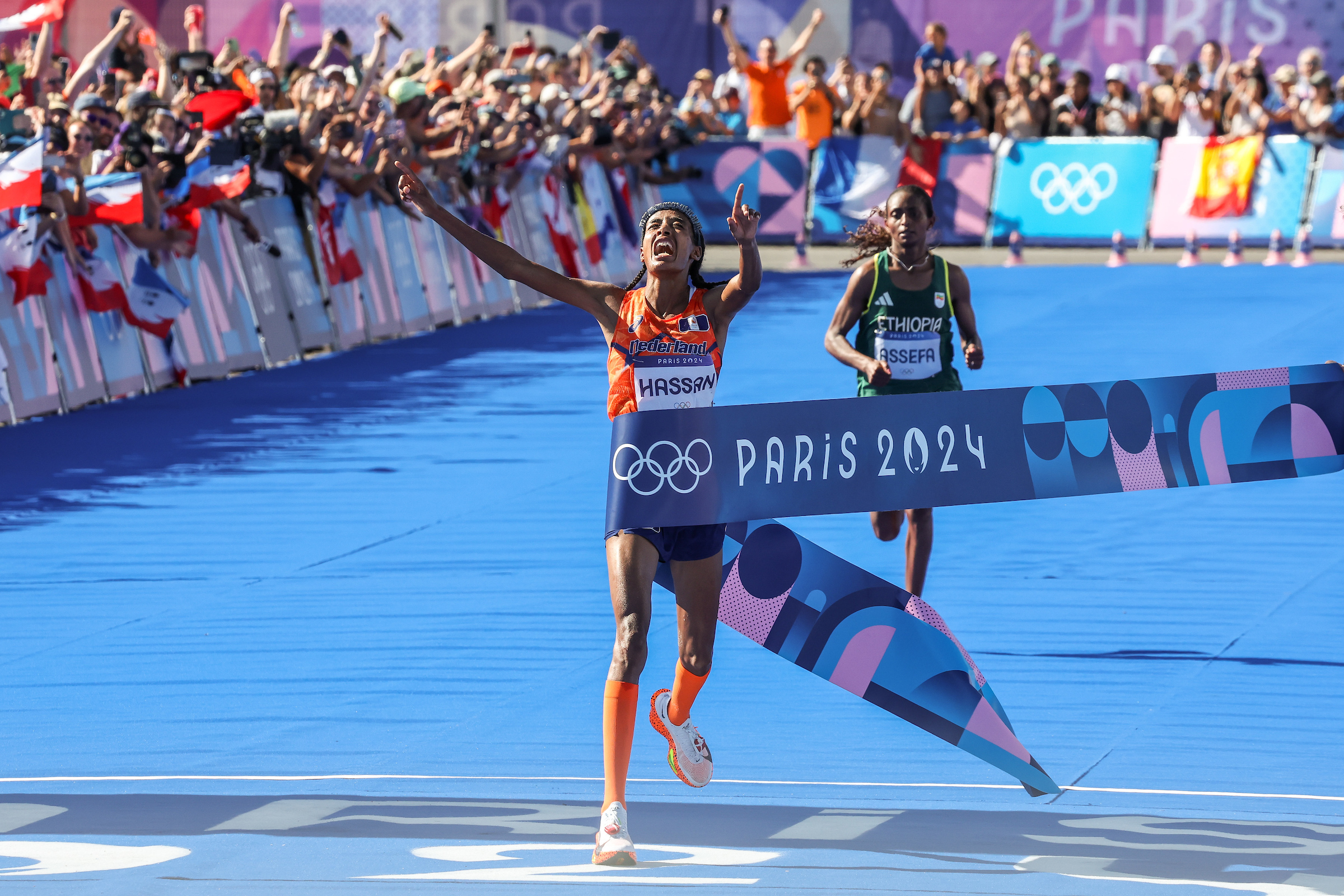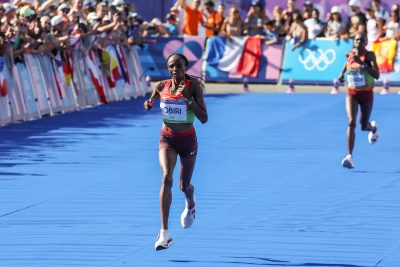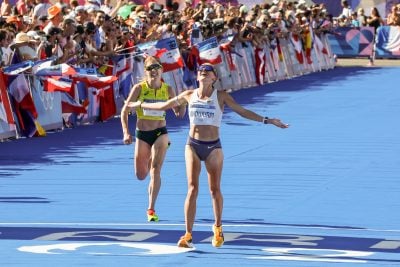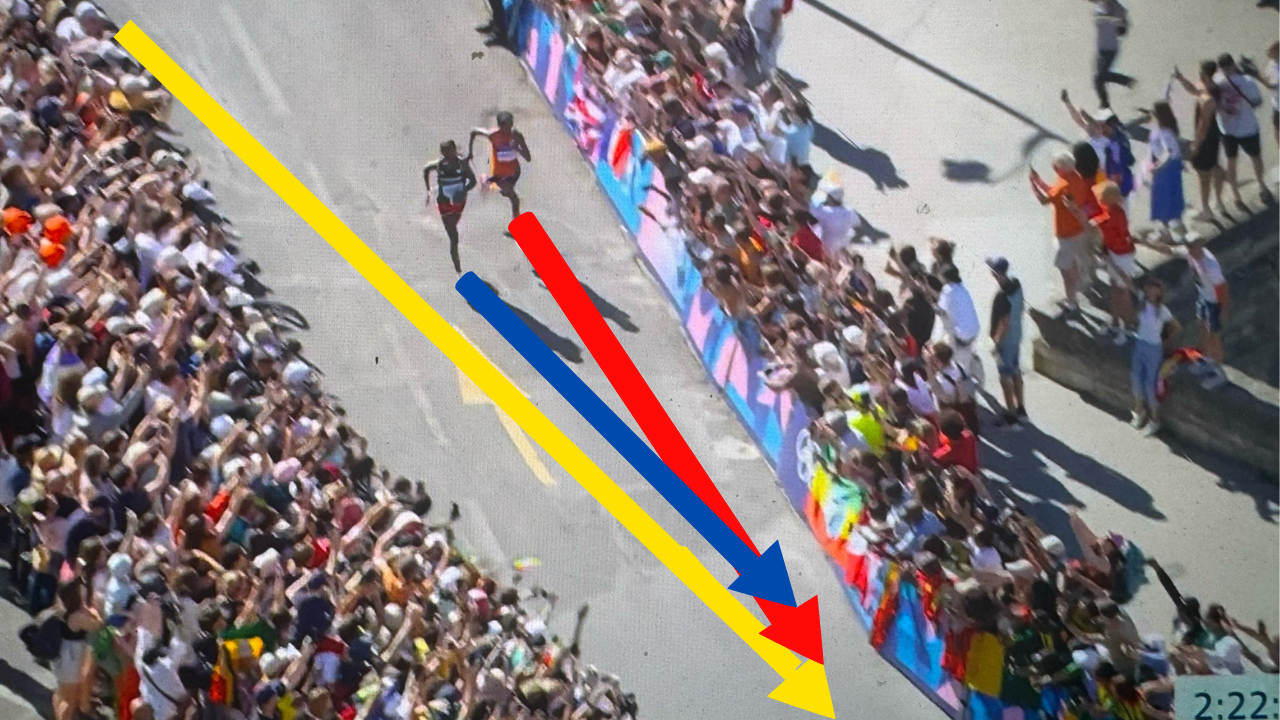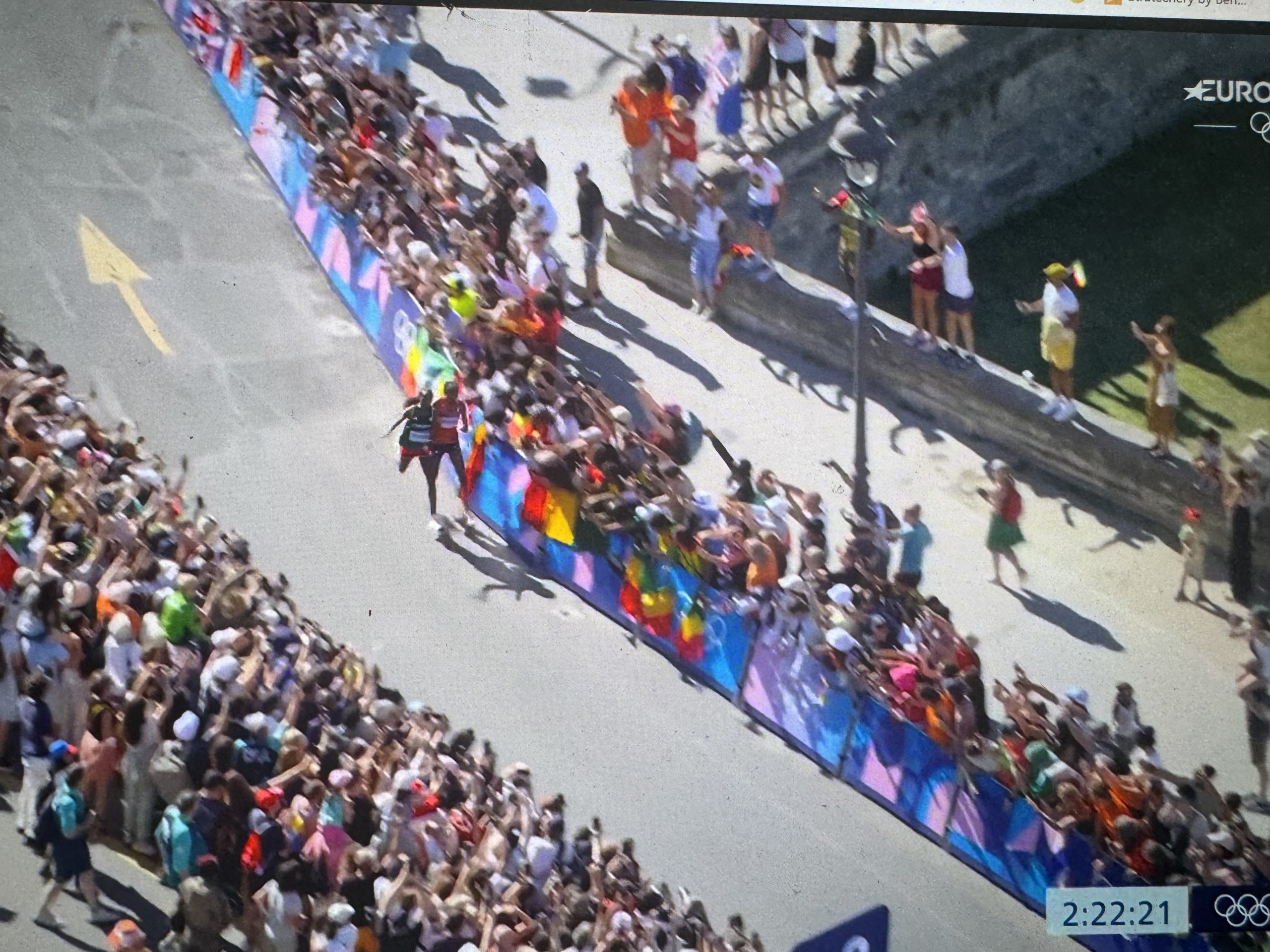Sifan Hassan Completes Olympic Triple by Outsprinting Tigst Assefa for Marathon Gold
By Jonathan GaultPARIS – It sounds too contrived to be real. With less than 400 meters remaining in the 2024 Olympic marathon on Sunday morning, the race was down to an all-out sprint between the two fastest marathoners in history, Sifan Hassan of the Netherlands and world record holder Tigst Assefa of Ethiopia. A gold medal and the title of Olympic champion hung in the balance.
Typically in such situations, Hassan is favored, even though Assefa has good speed herself, having run the 800 meters at the 2016 Olympics (just like Hassan). A former world champion at 1500 meters, Hassan won her marathon debut in London last year in similar fashion. But as usual, Hassan had set herself a challenge. She had already run the 5,000 meters in Paris, earning a bronze medal on Monday. And she had run the 10,000m, taking another bronze on Friday night, just 37 hours before she was due to start the marathon. By the time she began kicking against Assefa, Hassan already had more than 38 miles of Olympic racing in her legs across the previous 10 days.
Yet it did not matter. Because Sifan Hassan is Sifan Hassan, a truly unique distance talent who dreams up fantastical feats, then goes out and achieves them. With the spectacular golden dome of Les Invalides for a backdrop on a glorious final morning of the 2024 Olympics, Hassan sprinted clear of Assefa to win the marathon in 2:22:55. It was an Olympic record on the hilliest course in Olympic history and the exclamation point on one of the most impressive feats in distance running history.
Hassan is the first woman to even attempt the 5,000/10,000/marathon triple at an Olympics, let alone medal in all three events. In terms of Olympic women’s distance feats, the only one that compares is the triple Hassan completed in Tokyo three years ago, where she earned bronze in the 1500 and gold in the 5,000 and 10,000. Those two triples now stand alongside Emil Zatopek’s 5,000/10,000/marathon gold in 1952 and Paavo Nurmi’s quintuple gold in 1924 as the greatest multiple endurance performances in Olympic history.
Assefa took the silver in 2:22:58 while Kenya’s Boston Marathon champion Hellen Obiri earned bronze in 2:23:10 despite falling twice and having to stop to throw up during the race.
US Olympic Trials third-placer Dakotah Lindwurm had a very strong run to lead the Americans. Twenty-seven seconds back at 15k, she thrived on the hills and rejoined the lead pack at halfway, briefly leading the race before finishing 12th in 2:26:45. American record holder Emily Sisson, who doesn’t thrive on hills, was 23rd in 2:29:53. Trials champion Fiona O’Keeffe was the latest American to try to run the Olympic marathon while injured and not make it to the finish line. In fact, she didn’t make it 5k and we’re not even sure if she made it a mile as she could be seen way behind the field less than 20 seconds into the broadcast, badly limping. She follows in the footsteps of Des Linden, who dropped out in 2012 London after two miles, and Aliphine Tuliamuk, who was a DNF in 2021 after 20k.
O’Keeffe had not raced since May and pulled out of the NYC Mini in June with a calf injury, but her coach Alistair Cragg told LetsRun.com they still were not completely sure the exact nature of the injury that ruled her out today. He said she had been experiencing hip flexor tightness in the last week and the issue was serious enough that USATF told alternate Jessica McClain to fly to Paris and be ready to go if needed (though O’Keeffe ultimately attempted to run).
The race
Conditions were slightly warmer than the men’s marathon one day earlier, with a starting temperature of 64 degrees and 78% humidity rising to 72 degrees by the finish under sunny skies. Australia’s Jessica Stenson was the early leader at halfway, which she passed in 1:13:22 at the front of a large group of 20 women. A few minutes later, as the field approached the Palace of Versailles, Lindwurm got some time in the spotlight as she took the lead.
But it would not last. Lindwurm had been reeled in and dropped by the time a lead pack of 10, which included Hassan 10 meters off the back, began the steep Wall Hill just before 29 kilometers. By the top of the hill, a group of four had separated: Ethiopians Assefa and Amane Beriso (the 2023 world champ), and Kenyans Sharon Lokedi (the 2022 NYC Marathon champ) and Peres Jepchirchir (reigning Olympic champ).
Those four would not stay separated, however, with the likes of Hassan, Obiri and Japan’s Yuka Suzuki catching back up on the steep downhills that followed, with the leaders covering the 30-35k stretch in 15:44 (by comparison, they had run the largely uphill 5k from 15-20k in 18:19). That left a lead group of six at 35k with the notable exception of Jepchirchir, who had nothing after the hills and faded to 15th in 2:26:51.
Gradually, the group would shrink with Suzuki falling off at 35k after a surge from Assefa and a surge from Obiri at a mile to go dropping Beriso and eventually, Lokedi.
Approaching a turn with just under 400m to go, Assefa made her bid for glory, but Hassan tracked it. Then: contact! The last quarter mile of the course featured five turns, and on the second one, Hassan tried to shoot a gap to the left of Assefa as the course veered slightly to the left. Assefa moved slightly inside trying to not give Hassan room and there was contact with the two women bouncing off each other as Hassan narrowly avoided the barricades to her left. Both women would stay on their feet and Hassan ultimately broke Assefa with just under 200m to go to win the gold in one of the most memorable finishes in Olympic marathon history.
Top results and full analysis appear below.
Top 12 Results *Full Results here
| pos | Country | Athlete | mark |
| 1 | NED | Sifan HASSAN | 2:22:55 OR |
| 2 | ETH | Tigst ASSEFA | 2:22:58 |
| 3 | KEN | Hellen OBIRI | 2:23:10 PB |
| 4 | KEN | Sharon LOKEDI | 2:23:14 PB |
| 5 | ETH | Amane Beriso SHANKULE | 2:23:57 |
| 6 | JPN | Yuka SUZUKI | 2:24:02 PB |
| 7 | ROU | Delvine Relin MERINGOR | 2:24:56 SB |
| 8 | UGA | Stella CHESANG | 2:26:01 |
| 9 | ISR | Lonah Chemtai SALPETER | 2:26:08 SB |
| 10 | BRN | Eunice Chebichii CHUMBA | 2:26:10 |
| 11 | MAR | Fatima Ezzahra GARDADI | 2:26:30 |
| 12 | USA | Dakotah LINDWURM | 2:26:44 |
Sifan Hassan amazes again
A month ago, when Hassan finished 5th in the 1500 at the FBK Games in Hengelo in 4:04.83, even an optimist would have had a hard time predicting three Olympic medals in Paris. But Hassan later revealed that she had been focusing on marathon training like never before and felt she was overtraining at the time of Hengelo. After backing off in the month before Paris, her kick was there when she needed it in the 5,000 and 10,000 and she still had the strength to race 26.2 miles at the end of the Games.
It cannot be overstated how difficult this triple was. Hassan was only beaten in the 5,000 by Beatrice Chebet (who looks like the next great distance superstar after winning the 10,000 as well) and one of the greatest female runners ever, Faith Kipyegon. Then she medalled again in the 10,000. That race ended just before 9:30 p.m. Paris time on Friday, less than 35 hours before the marathon started on Sunday morning. The night before the Olympic marathon, most women are conserving energy and moving as little as possible. Hassan was at the Stade de France receiving her 10,000m medal (fortunately the ceremony was on the early side, at 6:34 p.m.).
And as if doubling back from the 5,000 and 10,000 was not hard enough, Hassan had to face one of the best Olympic marathon fields ever assembled on the toughest course in Olympic marathon history. This race featured three of the five fastest women ever, as well as the reigning champions in Boston, London, New York, Chicago, Worlds, and the Olympics. Yet Hassan beat them all. What a run.
Does this make Sifan Hassan the greatest female distance runner ever?
Considering Hassan has won Olympic titles in the 5,000, 10,000, and now marathon in her career, along with world titles in the 1500 and 10,000 and major marathons in London and Chicago, there is a strong case to be made for Hassan as the greatest distance runner of all time. While Hassan has run fast – 3:51.95 for 1500 and 2:13:44 in the marathon (#2 all-time) as well as since-broken world records of 4:12.33 in the mile and 29:06.82 in the 10,000 – the argument for Hassan centers around her remarkable doubles and triples. Just look at this list:
-Double gold in 1500 and 10,000 at 2019 Worlds
-Double gold in 5,000 and 10,000, plus 1500 bronze at 2021 Olympics
-Won 2023 Chicago Marathon in #2 time ever just six weeks after 1500 bronze at Worlds
-Double bronze in 5,000 and 10,000, plus marathon gold at 2024 Olympics
All of those feats are unprecedented in the history of women’s distance running, and most are so insane that no other woman would even dare attempt them. Gudaf Tsegay, who won the 5,000 and 10,000 at the last two World Championships, tried the same 1500/5k/10k triple in Paris that Hassan attempted in Tokyo and finished 12th, 9th, and 6th.
The argument against Hassan is that Faith Kipyegon more thoroughly dominated a single event – she has won six global titles in the 1500 and has the WR in the 1500 and mile – while Tirunesh Dibaba has more total global golds (eight on the track, plus four more in XC – a surface Hassan has never won on). So it depends on what you value.
Either way, Hassan is undoubtedly one of the all-time greats, and her feats over the last two Olympics are the sort of legendary stuff we’ll still be discussing decades from now.
Hellen Obiri had to survive a rough race to get the bronze
Obiri was hoping to finally win an Olympic gold medal after getting silver in the 5,000 at the last two Games, but it was not to be. Yet she should be admired for persevering in a race where almost everything that could have gone wrong for her did. Obiri fell down very early in the race at 2k and had to catch back up to the leaders, and said she fell again at 30k and missed two drinks stations, which upset her stomach and forced her to stop to throw up.
But Obiri kept fighting her way back to the lead pack, and though she was ultimately outsprinted for the top two medals by Hassan and Assefa, she held it together for bronze on a rough day. Even if it was not the outcome she wanted, medalling in three straight Olympics is no easy feat.
“I had a lot of challenges, ups and downs,” Obiri said.
Dakotah Lindwurm had a lot of fun out there but was a little disappointed not to finish in the top 10
No matter what happens the rest of her life, Lindwurm will always have the memory of leading the Olympic marathon in the second half of the race. Lindwurm joked that she felt as if she had taken a Mario Kart shortcut to find herself in the front.
“I looked up and I said, ‘God, you’re crazy, I can’t believe I am in the front of the Olympic marathon right now,’” Lindwurm said. “You’ve got to put yourself in position to run well, and I’m not afraid to take the lead. I never have been.”
While Lindwurm was ultimately a little disappointed to miss out on her pre-race goal of top 10, her 2:26:44, 12th-place finish was very impressive given the course, the conditions, and the fact that almost no one expected her to even be on this team at the start of 2024.
Lindwurm also made sure to soak in the entire experience. She said she encountered a young American fan around 35k that made her day by running alongside her and shouting her name – “somebody’s gotta find me this kid, I need to give him a high-five” – and crossed the finish line with a smile on her face.
“I’m one to always react to the crowd,” Lindwurm said. “I like to be involved. I love what I do, and without the crowd, I don’t have a job. So I want to inspire them, I want to show them that marathoning is fun. Hopefully someone out there thought, oh she’s smiling at the end of it, maybe I can run one too.”
And for Lindwurm, today will be memorable for more than just the Olympic marathon – her boyfriend proposed after the race (she said yes).
Emily Sisson felt three marathons in 10 months was too much for her
Sisson doesn’t have a reputation as a great hill runner, but she did not think that was why she underperformed today by finishing 23rd in 2:29:53.
“I actually felt pretty tired before we hit the hills, so I was like, that’s not a good sign,” Sisson said. “But I’m proud I gutted it out.”
Prior to running 2023 Chicago and the 2024 Olympic Trials, Sisson had never run two marathons in back-to-back seasons and she felt that tacking on a third at the end was too much for her body.
“I’m pretty disappointed, I’m pretty sad,” Sisson said. “…I had some good workouts and no major injuries or anything…but this marathon [build] just didn’t feel quite like the last two the whole last three months. Just felt like I needed to freshen up my legs, and I tried so, so hard.”
***
Two Quick Takes by Robert Johnson on the Hassan/Assefa contact and American athletes DNFing Olympic marathons
Thank God someone didn’t go down when Hassan and Assefa bumped in the final 250m
If you watched this one live, you were probably shocked when you saw Hassan and Assefa bump violently with just 34 seconds left in the race when Hassan was trying to pass on the inside. Having watched the replay several times, we mainly blame the course organizers. There were a ton of turns in the final 400m that in hindsight were asking for disaster.
When there was just 45 seconds racing left, Assefa had the lead but the course made a super hard turn to the left. Hassan was full of run and wanted to pass Assefa on her right shoulder but there was no room to do without running into the fan barricades as the runners still needed to make a small left-hand turn, then another right-hand turn and then yet again a big right-hand turn before the finish.
So after Hassan realized she couldn’t get by on the right, she jumped to the left and committed herself to making her move there. The problem was, there was even less room on the left. The spectator barricades on the left-hand side of the course suddenly started to cut in at a much sharper angle and basically forced Hassan into Assefa.
See these two photos for a visual depiction of what we are talking about. (In the first photo, the yellow line is superimposed on top of the course’s tangent line that is used to measure the course. Assefa was running parallel to that, just a few feet to the left.)
Hassan was technically in the wrong. You can’t blast into someone from behind in a race (yes, it looks like Assefa leaned in as well, but she doesn’t have to let someone cut her off). But the course organizers were primarily to blame as the tangent of the course shouldn’t put you within two meters of the fan barricades, which are coming in at a sharper angle.
All we can say is thank goodness no one went down. Under the letter of the rules, Hassan should have just slowed down, but that’s not realistic to expect at that point in the race (it’s also not realistic for course organizers to expect Assefa to just let Hassan beat her to the pole there). If Assefa had gone down, this would have been a disaster as it’s possible Hassan would have been disqualified. Thankfully, Assefa stayed on her feet and the results ended up being just.
Officials in Paris said the post-race press conference, which Hassan skipped, was delayed because of a protest in the race – presumably by Ethiopia, though Assefa would not confirm that. The protest was denied.
“I didn’t expect that at that moment but that happens,” Assefa said after the race, via translation. The second part of her answer might have been lost in translation because the interpreter said “it was nice that Sifan didn’t push me at that moment” but then said “maybe if she didn’t push me I might have the gold.” She was later asked if the contact destroyed her chance at gold and answered simply, “yes.” But Assefa also made sure to congratulate Hassan, saying, “I am so happy for her that she gets a gold medal.”
Rojo’s Rant: Something needs to be done with these injured runners running the Olympics
One of the things we need to do at LetsRun.com after we recover from Paris is talk to some agents to see how shoe contracts work and see if they actually require you to run in the Olympics to get a bonus for making the team. We at LetsRun all agreed that if we were Fiona O’Keeffe, we wouldn’t turn down a large sum of money simply so Jess McClain – the Trials 4th placer — could run the race and finish probably 25th at best. What Sisay Lemma did in the men’s marathon was VERY admirable as he stepped aside, but he was replaced by a guy capable of winning the gold (who also happened to be his training partner). O’Keeffe was the USAs’ only potential medal hopeful in this race.
But to see O’Keeffe on the TV screen less than 20 seconds into the race limping and way behind all of the runners was hard to watch. This needs to stop. Shoe contracts need to be rewritten so people can say, “I qualified for the Olympics but turned it down as I was injured” and not be killed financially.
The people who should feel the real outrage aren’t the American fans, however. It should be the Aussie fans. A committee picks the Aussie team. Thus to see 47-year-old Sinead Diver drop out before the first mile should make everyone in Australia irate. There was A LOT of controversy about who made the Aussie team and in the end the committee ran a woman who couldn’t make it mile? Even though lots of people in Australia knew Diver was hurt and the alternate contacted Athletics Australia on July 23 to see if she should pack her bags and head to Paris? That’s disgraceful.
- No O’Keeffe in marathon? She was in there but not for very long. We saw her visibly limping and way behind the field 19 seconds in.
- Is Athletics Australia Corrupt and is Nic Bideau the leader? The Aussie selectors should be ashamed as Sinead Diver dropped out at 1.2km.

